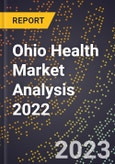In 2019, Anthem Blue Cross Blue Shield Had an After-Tax Net Income of $352.2Million, or 5.9% of Revenues
This report analyzes the healthcare insurance and provider markets in Ohio. The report describes key trends for healthcare organizations and analyzes their competitive strategies.
In the midst of the COVID-19 pandemic, Ohio hospital systems reported strong profits in 2021 from both patient care operations and other revenues, including federal provider relief funds. Ohio HMOs increased their enrollment by 8% in 2021, with gains in Medicare Advantage, Medicaid and individual health plans.
The Ohio Health Market Review 2022 finds:
- Based on an analysis of Medicare cost report data for 2021 operations, Ohio hospital systems enjoyed very strong profits in 2021. In general, the systems were profitable on their patient care operations and had significant additional revenues from investments, philanthropy and government grants, including $814.8 million in federal Provider Relief funds in 2021 and $1.957 billion in 2020. (Note that cost report data for 2022 is not available yet and while some systems continue to report strong net income, others have reported losses in 2022 because of higher labor costs and losses on investments.) In the Cincinnati Dayton area, hospitals had net income of $2.302 billion, or 17.6% of net patient revenues of $13.068 billion. The two Dayton systems, Kettering Health Network and Premier Health, were especially profitable, with margins of 19.1% and 21.5%, respectively.
- In the Cleveland-Akron region, hospitals reported combined net income of $3.119 billion or 17.9% of revenues. The Cleveland Clinic system accounted for almost 75% of total net income in the region and had a combined margin of 24.4%. In the Columbus area, hospitals had a net income of $2.284 billion, or 20.5% of net patient revenues, with Nationwide Children’s accounting for one-third of that and the OhioHealth hospitals having 40%.
- Strong population growth in the Columbus region has spurred large capital investments by the local hospital systems, especially the Ohio State University and Nationwide Children’s. Nationwide, which is spending $3.3 billion on a new inpatient tower, research buildings and specialty centers, acquired Mercy Children’s hospital in Toledo. OhioHealth acquired two hospitals at the end of 2022, bringing that system to 14 hospitals across the center of the state.
- After reporting record profits in 2020, Ohio HMOs and health insurers reported very strong results in 2021. HMOs had net income of $551.4 million, down from $619.1 million in 2020, when healthcare utilization and claims dropped sharply. Two HMOs, Molina Healthcare and UnitedHealthcare, accounted for half of the profits in 2021. Anthem Blue Cross Blue Shield had net income of $319.7 million in 2021, while Medical Mutual reported $108.3 million.
- Medicaid managed care is a huge and very profitable business opportunity in Ohio. In 2021, the six HMOs contracting with Ohio Medicaid had underwriting profits (not including investment income) of $607.3 million or 2.9% of revenues.
- Enrollment in Medicaid managed care plans continues to grow. In 2022, 3.3 million Ohio residents were enrolled in Medicaid, and 87% of them are in six managed care plans. Enrollment in Medicaid HMOs grew by 7.5% in 2021 and by 1.3% in the first half of 2022. Ohio is implementing new contracts for Medicaid managed care, which will link payment to performance while reducing administrative costs. CareSource remains the largest Medicaid HMO in Ohio, with 1.43 million enrollees. Its efforts to expand by winning contracts in Iowa and Oklahoma have not been successful. Buckeye Community (Centene) and UnitedHealthcare Community Plan are the next largest Medicaid plans.
- Medicare Advantage enrollment has grown steadily, and about 53% of Ohio’s 2.4 million Medicare beneficiaries are in a Medicare Advantage plans, an increase of 15.6% in two years. Anthem Blue Cross Blue Shield has the largest number of Medicare HMO enrollees, followed by UnitedHealthcare, while Aetna and Humana have the largest Medicare PPO plans in the state. Enrollment in HMO and PPO individual plans grew by 16% in the first half of 2022.
Table of Contents
1. Introduction
Samples

LOADING...
Companies Mentioned
- Aetna
- Anthem Blue Cross Blue Shield
- Buckeye Community
- CareSource
- Cleveland Clinic
- Humana
- Kettering Health
- Medical Mutual
- Mercy Children’s Hospital
- Molina Healthcare
- Nationwide Children’s Hospital
- Ohio State University
- OhioHealth
- Premier Health
- UnitedHealthcare
Methodology
The reports analyzing state health care markets are intended to be a resource to health care organizations facing a full range of challenges but also seeking to identify and benefit from opportunities that present themselves.
This report is presented in three main sections. The first part, Market Structure, describes the major health insurers and hospital systems in the state, showing recent entrants and the high-level of consolidation that has occurred in both the health plan and provider markets. Market Trends, the next section, presents our analysis of enrollment trends and financial results for the health insurers. The last section contains our analysis of financial and inpatient utilization data on the hospitals in the state.
The analysis of health plan companies is based on their annual and quarterly statements filed with the Department of Insurance, including forms prescribed by the National Association of Insurance Commissioners and supplemental reports required by the state. The publisher also uses Medicaid data from the Department of State Health Services and Medicare health plan and hospital data from the Centers for Medicare and Medicaid Services. The publisher has that data together with insights that they have gained in interviews with dozens of leaders in health care organizations in the state.

LOADING...








